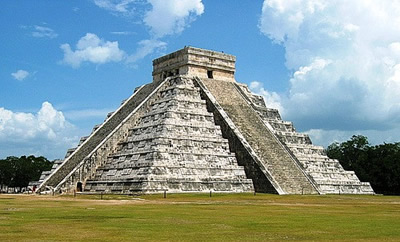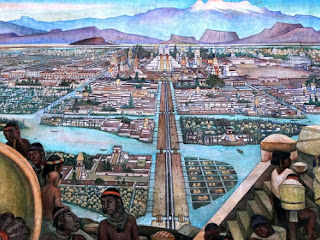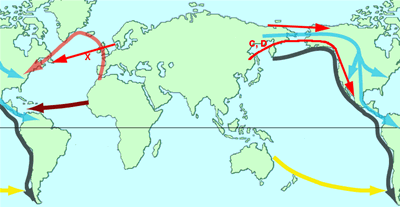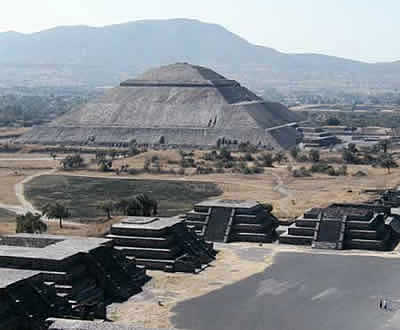 |
| Maya Classic Period |
During the Classic Period, which is divided into Early (250–600 c.e.), Late (600–800), and Terminal (800–900/1100), Maya civilization reached the pinnacle of its cultural, economic, and political development.
From the 200s to the 400s c.e. dozens of autonomous city-states, many founded in the Preclassic, others early in the Classic, jockeyed for power. By the 500s two had gained preeminence: Tikal and Calakmul.
These were sprawling city-states of 100,000 people or more, with towering pyramids and temples, massive civic and ceremonial centers, outer rings of lesser compounds and residences, and intensively farmed hinterlands extending many miles. A hereditary king and a small class of elites controlled vital trade routes and secondary centers and aggressively pursued conquest of and alliances with other polities.
From the 500s to the 700s a series of highly destructive wars erupted between these two great powers and their respective allies. Elsewhere in the Maya zone other city-states engaged in the same process of expansion, alliance building, and warfare.
Then, for reasons still much debated, in the 700s and 800s all of these polities underwent steep declines, with more than a dozen major and scores of lesser urban complexes abandoned by the early 900s. A resurgence in northern Yucatán, beginning in the 800s and marked especially by the rise of Chichén Itzá, also declined by the late 1000s.
This 600- to 800-year period saw the flourishing of commerce, architecture, engineering, writing, mathematics, calendrics, astronomy, cosmology, and artistic creations of every description across the Maya zone, achievements that emerged together as part of a broader process of cultural, economic, and political development.
Mayan writingWhile the origins of Mayan writing in the Middle Preclassic remain obscure, by the Late Classic the Maya had developed the most sophisticated writing system in the history of the pre-Columbian Americas, one of only a handful of independently invented writing systems in the history of the world.
After more than a century of painstaking effort by scholars on several continents, breakthroughs in the 1970s and 1980s permitted many of these ancient texts to be read for the first time.
By the Early Classic anything that could be spoken in Maya could be rendered as written text. Using a script consisting of more than 800 glyphs in a characteristic round or oval shape and intricate style, Mayan writing employed both logographs and phonetic signs.
Read from top to bottom and left to right, these glyphs are classified as "main signs” and "affixes", with the latter made up of prefixes, suffixes, superfixes, subfixes, postfixes, and infixes.
Such written texts, often accompanied by dates and graphic depictions of human figures and divine entities (stylistically not altogether unlike contemporary graphic novels), appear on carved monuments, murals, pottery, other artifacts, and a handful of surviving folded-paper codices.
The Spanish destroyed hundreds and perhaps thousands of these codices during the conquest, a purposeful eradication of vast quantities of accumulated knowledge on par with the burning of the library of Alexandria.
Most extant texts memorialized significant episodes in the lives of kings, though many recorded wars, dynastic alliances, and other major events. (Many personal items conveyed more prosaic information, such as "his cup" or "his bowl").
If only a tiny fraction of the populace could write or read, the prominent display of these texts in civic and ceremonial spaces on imposing and magnificently carved stone stele, stairways, altars, lintels, and other public monuments were clearly intended to convey unequivocal messages of the king’s divine power to all who bore witness to them.
Maya InnovationsIntimately linked to writing and no less remarkable for their sophistication were Maya mathematics and calendrics. Having invented the mathematical concept of zero—evidently making them the world’s first civilization to do so—the Maya went on to undertake fantastically
complex mathematical calculations.
Their numerical system was vigesimal (based on the number 20), most commonly written using a bar-and-dot notation, with a dot representing one; a bar, five; and a shell-like figure, zero. With these simple notations they were able to calculate numbers into the millions and accurately predict lunar and solar eclipses thousands of years into the
future.
The Maya conceived of time as a series of recurring cycles. All Mesoamerican peoples shared three cyclical calendars: the 365-day solar year, the 260-day sacred almanac, and the 52-year "calendar round". These three calendars, which can be visualized as three interlocking wheeled gears, made each of the 18,980 days of the 52-year "calendar round" unique.
The Maya added to this what scholars call the "Long Count" or "Initial Series", which was independent of the other cycles and served as an absolute chronology by tracking time from a fixed or "zero" date far in the past. Evidently they were the first world civilization to mark time from a fixed date.
According to the Long Count, the world came to an end and was created anew every 5,128 solar years, at the close of each "great cycle". The current world, by this calendar, will end on December 21, 2012.
Like all Mesoamerican civilizations, the Maya invested the movements of the
Moon, Sun, planets, and stars with deep religious and cosmological significance, often designing and constructing their temples, shrines, and other edifices to align with astronomical observations.
These celestial bodies represented gods and deities, and there is no evidence that the Maya understood the circular or elliptical orbits of the Moon, Earth, and planets as discovered by Copernicus and Kepler centuries later.
Maya religion and cosmology were exceedingly complex, an all-encompassing system of belief in which the distinction between sacred and secular did not exist. Rivers, rocks, caves, springs, and other natural features were seen to possess divine powers, while a multiplicity of spirits and deities, including ancestor spirits, infused every aspect of everyday life.
Creation myths emphasized the cyclical re-creation of the world by dualistic divine beings who entered Xibalbá, or the Otherworld, "a place beyond death inhabited by ancestors, spirits, and gods—the place between the worlds", according to Friedel et al., outwitted the gods, and became divine kings.
The most elaborate Maya treatment of creation myths and cosmology is the
Popol Vuh, a uniquely revealing book written by the highland K'iche (Quiché) Maya after the Spanish conquest.
Economy, Society, and PoliticsThe economic foundations of Classic Maya city-states and kingdoms consisted of extensive and intensive agriculture supplemented by hunting, fishing, and gathering; craft specialization; and local, regional, and longdistance trade, all of dizzying complexity.
Society was divided into two broad groups: a tiny group of elites and the great majority of commoners, with fine gradations in status at all levels. In some instances a more prosperous strata of commoners emerged, though on the whole wealth and power were highly centralized and concentrated in very few hands.
Political power was exercised by hereditary ruling dynasties. At the pinnacle stood the king ("sacred lord", or k'uhul ajaw), almost always male and considered a divine or semidivine being. Beneath him was a small group of high-ranking elites—warriors, high priests, scribes, and administrators.
Interstate politics were byzantine, with alliances between polities generally consummated through dynastic marriages. Kingdoms were formed by conquest and domination of lesser polities, whose ruling houses the conquering power generally left intact.
The decline of the massive city-state of El Mirador in the late 100s c.e. created a power vacuum in the lowlands that was soon filled by other emergent polities, most notably Tikal and Calakmul. From the 100s to the late 300s, when it allied with mighty Teotihuacan, Tikal became the preeminent Maya kingdom, its power stretching from the northern lowlands as far south as Copán in Honduras.
In the 400s Calakmul began to challenge Tikal through conquests and alliances intended to encircle and weaken its adversary. In 562 Calakmul defeated and sacked Tikal. There followed a period of intense conflict lasting more than a century.
"The giant war went back and forth", in the words of Arthur Demarest, until 695, when Tikal "roared back and crushed Calakmul. And then the Maya world just broke up into regional powers, setting the stage for a period of intensive, petty warfare that finally led to the collapse of the Maya".
During the Late Classic, similar processes unfolded to the southwest among the kingdoms of the Usumacinta River, most notably in the centuries-long conflict between Piedras Negras and Yaxchilán.
The war between these two regional powers and their allies raged off and on from the 400s to the 800s, finally ending in the defeat of Piedras Negras in 808. Another major regional conflict between Copán and Quiriguá, far to the south along the contemporary Guatemala-Honduras border, had a similar denouement.
By the 800s, as the kingdoms of the southern and central lowlands declined, the northern lowlands saw numerous polities rise to prominence in the 900s and 1000s, particularly in the Puuc region of western Yucatán. To the east the kingdom of Chichén Itzá, founded in the late 700s, soon became the most powerful and populous state in all of Maya history.
With a more decentralized political structure and diversified economic base than its weakening southern neighbors, Chichén Itzá prospered from the 800s through the 1000s, when it too experienced a period of decline and was all but abandoned by 1100.
Causes for DeclineA complex combination of factors most likely caused the decline of Classic Maya polities. Despite much variability in time and place, the most plausible scenarios point to the interplay of overpopulation, long-term ecological crises, endemic warfare, and the erosion of the moral legitimacy of divine kings in the eyes of the populace.
By the 800s the Maya lowlands were inhabited by tens of millions of people, probably exceeding the carrying capacity of the land even under optimal conditions.
Over time, surging population densities and ever more intensive and extensive agriculture and urban construction led to widespread deforestation, worsening soil erosion, and declining soil fertility, in some cases exacerbated by prolonged drought. The evidence shows that these processes caused increasing incidences of malnutrition and disease and fundamental ecological bottlenecks that in the end proved insoluble.
Endemic warfare was both symptom and cause of these deleterious processes. By the early 500s warfare was consuming prodigious quantities of material and human resources, and by the late 700s the cycles of violence had begun spinning out of control, with a series of ever more destructive wars overtaxing not only the land and the people but, no less important, commoners' faith in the moral legitimacy of their kings.
Since Maya kings ruled by virtue of divine sanction, any prolonged crisis—economic, ecological, political—could set in motion a profound spiritual-religious-moral crisis among the general populace, whose labor and faith were necessary to keep the whole system operating.
All of these factors, working in dynamic and contingent combination, were most likely responsible for the decline of one of the world's most
creative, original, and sophisticated civilizations.






















